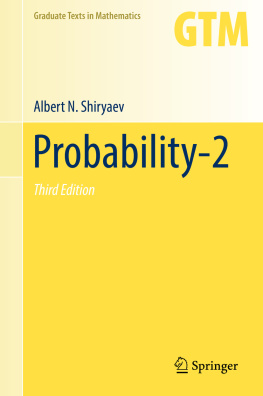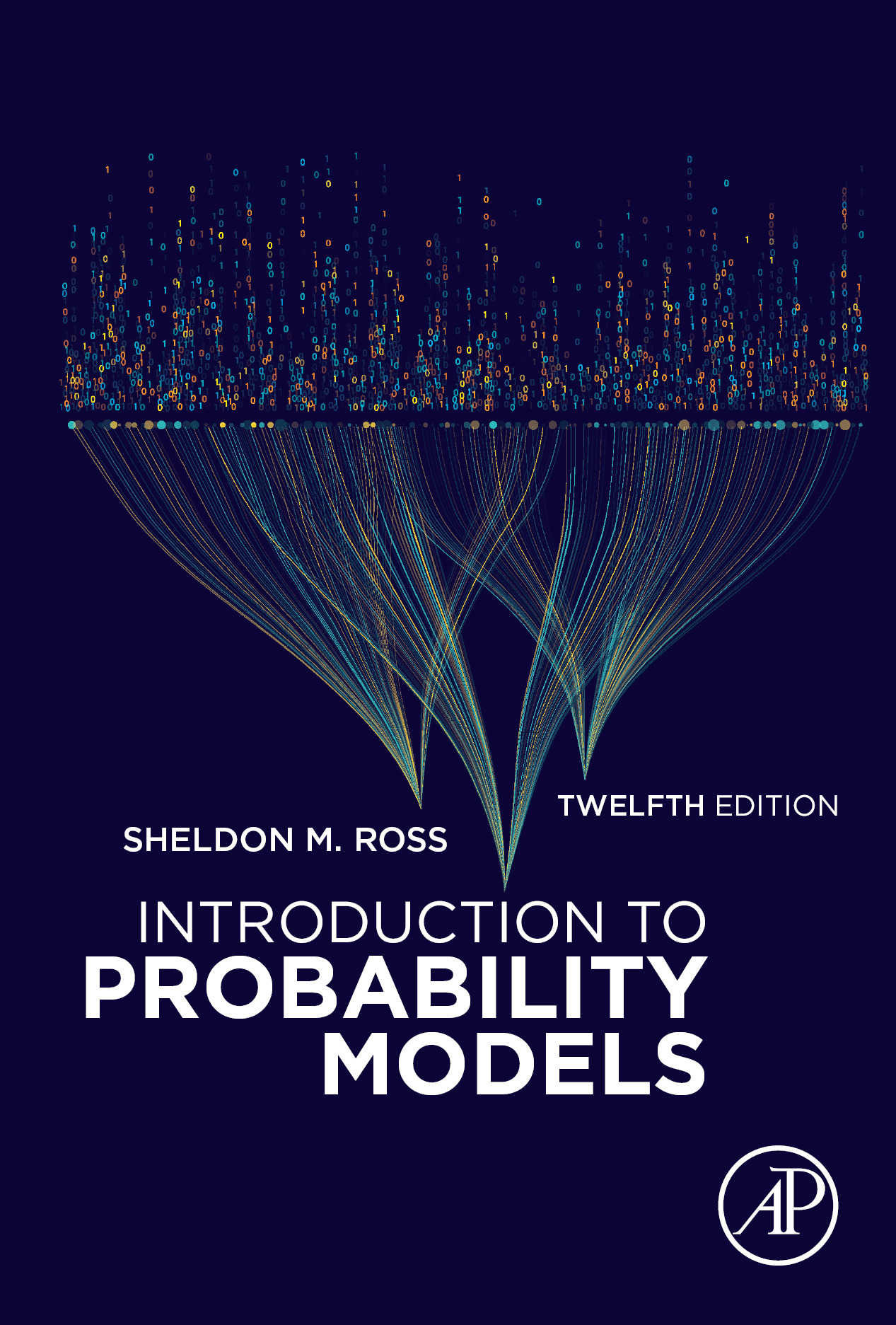Introduction to Probability Models
Twelfth edition
Sheldon M. Ross
University of Southern California, Los Angeles, CA, United States of America

Table of Contents
List of tables
- Tables in 2
- Tables in 7
- Tables in 11
List of figures
- Figures in 2
- Figures in 3
- Figures in 4
- Figures in 5
- Figures in 6
- Figures in 7
- Figures in 8
- Figures in 9
- Figures in 10
- Figures in 11
- Figures in 12
Landmarks
Copyright
Academic Press is an imprint of Elsevier
125 London Wall, London EC2Y 5AS, United Kingdom
525 B Street, Suite 1650, San Diego, CA 92101, United States
50 Hampshire Street, 5th Floor, Cambridge, MA 02139, United States
The Boulevard, Langford Lane, Kidlington, Oxford OX5 1GB, United Kingdom
Copyright 2019 Elsevier Inc. All rights reserved.
No part of this publication may be reproduced or transmitted in any form or by any means, electronic or mechanical, including photocopying, recording, or any information storage and retrieval system, without permission in writing from the publisher. Details on how to seek permission, further information about the Publisher's permissions policies and our arrangements with organizations such as the Copyright Clearance Center and the Copyright Licensing Agency, can be found at our website: www.elsevier.com/permissions.
This book and the individual contributions contained in it are protected under copyright by the Publisher (other than as may be noted herein).
Notices
Knowledge and best practice in this field are constantly changing. As new research and experience broaden our understanding, changes in research methods, professional practices, or medical treatment may become necessary.
Practitioners and researchers must always rely on their own experience and knowledge in evaluating and using any information, methods, compounds, or experiments described herein. In using such information or methods they should be mindful of their own safety and the safety of others, including parties for whom they have a professional responsibility.
To the fullest extent of the law, neither the Publisher nor the authors, contributors, or editors, assume any liability for any injury and/or damage to persons or property as a matter of products liability, negligence or otherwise, or from any use or operation of any methods, products, instructions, or ideas contained in the material herein.
Library of Congress Cataloging-in-Publication Data
A catalog record for this book is available from the Library of Congress
British Library Cataloguing-in-Publication Data
A catalogue record for this book is available from the British Library
ISBN: 978-0-12-814346-9
For information on all Academic Press publications visit our website at https://www.elsevier.com/books-and-journals

Publisher: Katey Birtcher
Acquisition Editor: Katey Birtcher
Editorial Project Manager: Susan Ikeda
Production Project Manager: Divya Krishna Kumar
Designer: Matthew Limbert
Typeset by VTeX
Preface
This text is intended as an introduction to elementary probability theory and stochastic processes. It is particularly well suited for those wanting to see how probability theory can be applied to the study of phenomena in fields such as engineering, computer science, management science, the physical and social sciences, and operations research.
It is generally felt that there are two approaches to the study of probability theory. One approach is heuristic and nonrigorous and attempts to develop in the student an intuitive feel for the subject that enables him or her to think probabilistically. The other approach attempts a rigorous development of probability by using the tools of measure theory. It is the first approach that is employed in this text. However, because it is extremely important in both understanding and applying probability theory to be able to think probabilistically, this text should also be useful to students interested primarily in the second approach.
New to This Edition
The twelfth edition includes new text material, examples, and exercises in almost every chapter. Newly added Sections begin in Chapter on coupling methods. Its usefulness in analyzing stochastic systems is indicated throughout this chapter.
Course
Ideally, this text would be used in a one-year course in probability models. Other possible courses would be a one-semester course in introductory probability theory (involving Chapters , as the basis of an introductory course in queueing theory.
Examples and Exercises
Many examples are worked out throughout the text, and there are also a large number of exercises to be solved by students. More than 100 of these exercises have been starred and their solutions provided at the end of the text. These starred problems can be used for independent study and test preparation. An Instructor's Manual, containing solutions to all exercises, is available free to instructors who adopt the book for class.
Organization
Chapters gives a proof of the strong law of large numbers, with the proof assuming that both the expected value and variance of the random variables under consideration are finite.
Chapter presents k-record values and the surprising Ignatov's theorem.
In Chapter introduces Markov chain Monte Carlo methods. In the final section we consider a model for optimally making decisions known as a Markovian decision process.
In Chapter we are concerned with a type of stochastic process known as a counting process. In particular, we study a kind of counting process known as a Poisson process. The intimate relationship between this process and the exponential distribution is discussed. New derivations for the Poisson and nonhomogeneous Poisson processes are discussed. Examples relating to analyzing greedy algorithms, minimizing highway encounters, collecting coupons, and tracking the AIDS virus, as well as
material on compound Poisson processes, are included in this chapter. Section gives a simple derivation of the convolution of exponential random variables.
Chapter presents the computationally important technique of uniformization.
Chapter , we suppose the random variables are continuous and derive an expression for the mean time until a run of m consecutive increasing values occurs.
Chapter , concerned with a single server, general service time queue in which the arrival source is a finite number of potential users.
Chapter analyzes a series structure reliability model in which components enter a state of suspended animation when one of their cohorts fails.
Chapter is concerned with Brownian motion and its applications. The theory of options pricing is discussed. Also, the arbitrage theorem is presented and its relationship to the duality theorem of linear programming is indicated. We show how the arbitrage theorem leads to the BlackScholes option pricing formula.














